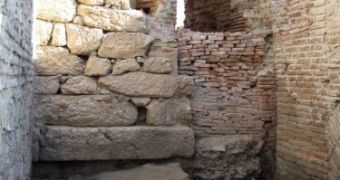The oldest Roman baths in Asia Minor were discovered this summer in Sagalassos, Turkey, by an archaeological team led by Professor Dr Marc Waelkens, L. Baert-Hofman Professor of Eastern Mediterranean Archaeology at the Katholieke Universiteit Leuven, Belgium.
For the last 21 years, Waelkens has directed excavations at the sight in Sagalassos every summer, and this year he discovered the oldest bath complex in Asia Minor.
Previously, the oldest known Roman bathing complex was Hitherto, the Capito Baths in Miletus, built during the reign of Emperor Claudius (41-54 AD), but now, this second bathing complex below the Imperial Baths (ca. 120-165 AD – with a surface area of more than 5,000 square meters), has taken its place.
This new complex is much older and smaller that the Imperial Baths and it is believed to data between 10 and 30 AD, even if it is possible that it was built before, during the time of Augustus or Tiberius.
This very well preserved complex measures 32.5 by 40 meters and it's walls must have been at least 12 meters tall, as today they still measure 8.5 meters.
When Hadrian chose Sagalassos as the center of the Imperial cult for all of Pisidia, to which the city belonged, these Old Baths were replaced with the Imperial Baths.
According to the Roman and Italian bathing habits, these baths must have had a succession of a warm pool, a hot water pool and a cold water pool, each one being housed in a separate space - a “tepidarium”, a “caldarium” and a “frigidarium”.
After Sagalassos became so important, there were festivals and games(agones) organized here, events that attracted thousands of people, making the building of a bigger infrastructure necessary.
This summer, other excavations allowed the discovery of a facade of an important building, maybe the town hall, dating from the reign Emperor Augustus (25 BC - 14 AD).
Also, the triumphal arc that was believed to have been built for Caligula, was actually in honor of his uncle and successor Claudius (41-54 AD) and Claudius’ brother Germanicus, Caligula’s father.
At the end of the excavation period, at the site was inaugurated an Antonine Nymphaeum, or a monumental fountain, reconstructed using almost only original stones.
Marc Waelkens has been involved in surveys and excavations in Greece, Syria, and Turkey since 1969. He specializes in Anatolian archaeology of the Graeco-Roman period and in ancient quarrying and stone technology.
On November 16, 2009, he was knighted by His Majesty, King Albert of Belgium.

 14 DAY TRIAL //
14 DAY TRIAL //